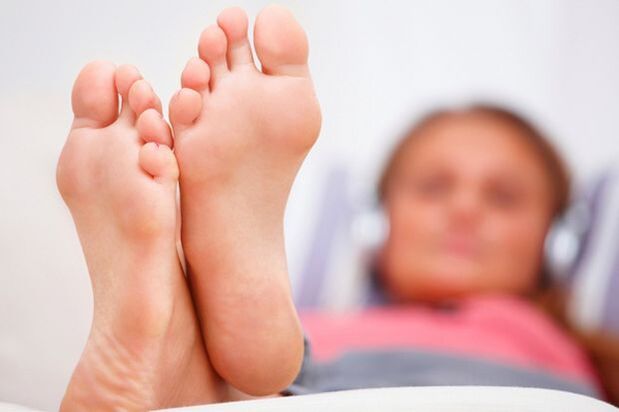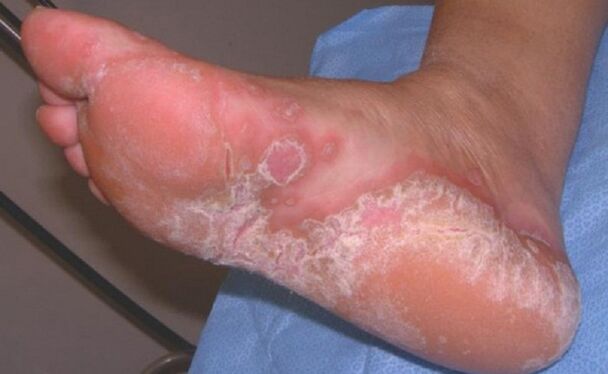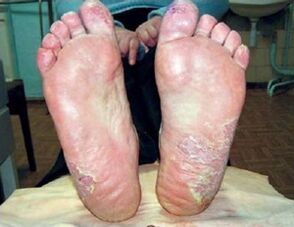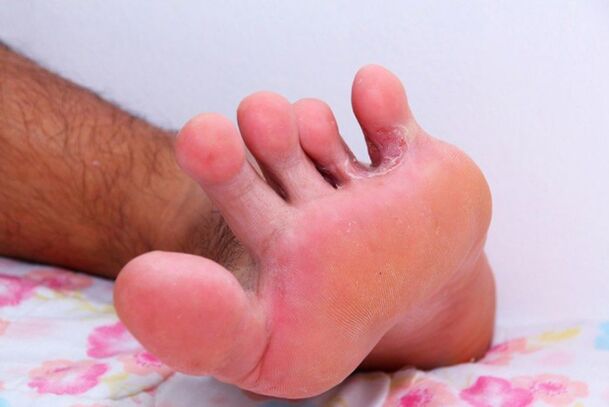Foot flexibility (mycosis) is a fairly common disorder marked by damaged skin.
Infection occurs during healthy skin contact with spore carriers, and through household routes: through shoes, shared bathrooms, and contaminated items. A fungal infection easily penetrates the interdigital fold (under favorable conditions), where it begins its path and population growth across the surface of the foot.

What are fungi?
Foot mycosis is the most common type of dermatophytosis and is characterized by chronic recurrence. It includes damage to the skin and nail layers. The constantly peeling upper layer of the skin contains a lot of fungi and their spores.
Fungus is an infectious disease that spreads from person to person through household items. The interdigital folds are affected first, so there is itching. After that, the infection covers the entire area of the foot. The disease progresses rapidly and is characterized by itching, burning, pain, dry skin, peeling and even diaper rash.
Reason for appearing
The main causes of the disease are microorganisms of the genus Trichophyton as well as molds. Infections occur when:
- Wear tight-fitting shoes (cracks and bedsores can form when feet are squeezed, making them susceptible to infection);
- Excessive sweating of the legs (this is an excellent environment for fungal populations to develop);
- High humidity in the room (shower, bathroom) - favorable conditions for all types of fungi;
- Frequent visits to saunas, swimming pools (increased risk of contact with infected persons);
- There are sick people at home (you can get infected through household items: slippers, socks and shared bathroom).
There are also diseases that are susceptible to fungal infections:
- Immunodeficiency (a weakened immune system makes it more susceptible to infectious and bacterial diseases);
- taking hormonal drugs (violating hormone levels);
- Flat feet (a disease that makes it difficult to choose shoes that raise the right foot and often squeezes the legs);
- Varicose veins (dry skin due to poor circulation);
- atherosclerosis;
- Diabetes mellitus (increased capillary permeability, changes in its barrier function).
symptom

The main symptoms of foot mycosis are:
- burning and itching between the toes of the lower extremities (initial form) and the entire surface of the foot (later form);
- Pain sensation (varies in intensity: the pain will intensify and then disappear completely within a short period of time);
- redness of the skin (from a slight pink to purple);
- dryness and extensive flaking (separation of scales and scabs from plaques);
- Cracks in the skin of the feet (which cannot be eliminated by traditional moisturizers);
- Changes in nail color and structure (they thicken and fall off);
- There is an unpleasant foot odor (if not previously observed).
important!
For fungal infections, the usual hygiene procedures (foot washing, pumice and steam) will not produce any results, the symptoms will not go away!
Why do you need fungus treatment?

The success of treatment depends on the correctness of the diagnosis and identification of the exact type of foot mycosis causative agent. Regardless of the form and stage of the fungal infection, a comprehensive approach is used in treatment.
The fungus doesn't go anywhere without an effective treatment, and it's not a disease that goes away on its own.
After all, the excrement of the parasitic bacteria can spread to the surrounding tissues, enter the bloodstream, become poisoned, which is an allergen to the human body (and may even develop into eczema).
Also, people infected with the fungus are the source of the infection and are dangerous to others. After all, infection occurs through household items and skin-to-skin contact with an infected person.
fungal form
In total, 6 forms of foot fungal lesions are distinguished:
- Erased form. This is the original form with the difference: slight peeling in the folds between the fingers and small cracks on the surface that are not cause for concern.
- scaly. Small scales are present between the toes and on the sole surface. Apart from mild itching, there are no signs of inflammation.
- Hyperkeratotic form. Blue-red patches (pimples) that appear on the arch of the foot. Dry skin, moderate pain, and itching were noted.
- Staggered form. It looks similar to diaper rash. The skin at the interdigital folds is bright red, swollen and watery, and may even erode. Pain, burning and itching complete the picture.
- form of hyperhidrosis. Note the appearance of air bubbles, which are closed from above with a tight lid. They are located in the arch of the foot and are characterized by intense itching.
- acute form. The skin of the foot is covered with blisters and blisters containing purulent serous fluid, the opening of which leads to multiple erosions and deep fissures. Body temperature increased significantly, the skin of the legs was bright red, severe pain, difficulty walking, headache, and general weakness. Inguinal lymphadenitis develops.
virus diagnosis
The diagnosis of the disease is made by a dermatologist or mycologist (depending on the area and extent of the fungal infection) and is based on the detection of the fungus when the skin scales are examined under a microscope.
The skin is removed from the affected area of the foot by scraping, then treated with a special agent. During the process of examination under the microscope, experts determine the type of pathogen, or the fungus is grown in nutrient medium (it is easier to determine its type by increasing the population).
treatment method

The basic rule for treating mycosis of the legs is a comprehensive approach that includes not only the use of medications, the use of alternative treatments, but also careful care of the affected skin.
Before starting medication, you should consult a doctor who will identify the pathogen through laboratory tests. Foot mycosis should be treated under the close supervision of a doctor or in a hospital. Treatment is carried out in two phases: the preparation phase and the foundation phase.
The first involves reducing inflammation, as well as an initial steam treatment of the legs in a solution of potassium permanganate and boric acid to exfoliate the cuticle.
The second stage involves drug treatment.
Medication (ointments, creams, tablets, other medicines)
After removing the upper keratinocytes, a special cream containing antibiotics and corticosteroids is applied to the entire affected surface. After the inflammation is eliminated, cancel the foot bath. Further treatments include deep exfoliation with petrolatum salicylic acid.
It is applied to the lesion in a thin layer until the keratin granules are completely separated. Immunity-boosting therapies are also effective: take immunomodulators and vitamin complexes, because the stronger the body's defenses, the faster the disease goes away.
important!
The use of ointments is prohibited! They can cause oozing erosion.
Treating this disease with folk remedies can only be adjuvant therapy, not the main method of treatment.
folk remedies
Treatment should be systematic and include not only drugs but also folk remedies:
- Apple cider vinegar is considered the best formula because this fungus does not like acidic environments. The method of application is simple - apply a vinegar solution (concentration selected individually) to the affected area, put on socks and go to bed.
- Laundry soap and baking soda are another effective method. You'll need to grind 3 tablespoons of soap and add equal parts baking soda. Pour this mixture into hot water (at least 5 liters) and lower your feet for 15-20 minutes. After surgery, clean your feet with a nail file or pumice stone.
- In addition, glycerin and vodka also showed significant results. It is necessary to fill a purchased bottle of glycerin with alcohol every day (before going to bed), shake it and moisten the peeling skin with this composition.
- Coffee is effective against fungal diseases. You should brew strong coffee and soak your feet in the drink until it cools. It is recommended to perform this procedure for at least one week.
- Celandine is also a good helper for fungal infections. You need to pour 1 liter of water into the kettle, put it on the stove, bring to a boil and add 4 tablespoons. l. Herbs (boil for 5 minutes). In the resulting infusion, you'll need to let your legs soar for 3 weeks a day.

How to treat mold growing on children?
The treatment of fungal diseases in children is divided into several stages:
- steaming feet (in a solution of soda and laundry soap, or with apple cider vinegar, you can also use chamomile broth - an excellent preservative);
- Exfoliation of keratinized particles (with a pumice stone or a rough towel, rub the flaky surface until the upper layer of the epidermis peels off);
- Treat the affected area with 2% iodine to promote healing and disinfection (you can apply an iodine mesh to the infected skin);
- Apply miconazole- and nystatin-based creams (they are safe and very effective for children) and wear cotton socks (or special antibacterial socks) before bed.
prevent disease
The preventive measures are fairly simple and include the following:
- Follow personal hygiene rules (especially when visiting public swimming pools, baths and saunas). You must walk around in slippers, no bare feet on the floor, and no other people's shoes.
- When visiting, you should also ditch your slippers and go indoors wearing socks.
- Wash your feet with antibacterial soap and a towel every day before bed.
- Be sure to dry your feet after washing them (especially between the toes).
- When keratinocytes appear, they need to be handled with a pumice stone and scissors or forceps.
- Nails need to be trimmed in time to prevent delamination.
- If there are cracks on the feet, special gels and creams must be used.
- Tight shoes are not allowed as it can impair blood circulation.
- If there are wounds and scratches on the skin of the feet, it is necessary to treat them with bright green.
- With increased sweating of the feet, it is necessary to use special sprays and gels (not sold in any pharmacy).
in conclusion
Foot mycosis is an insidious disease that not only causes discomfort and spoils the appearance of the skin and nails, but also eczema and a weakened immune system. In order not to be infected by fungi, it is necessary to observe basic hygiene standards.
Well, in the event of an infection - urgently seek the advice of a specialist who will diagnose and prescribe an effective treatment. If treatment is started on time, it is easy to defeat mycosis.
















